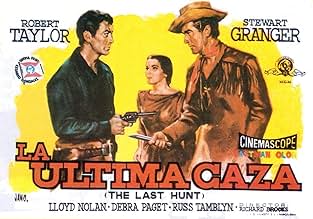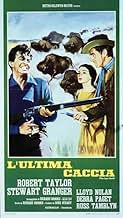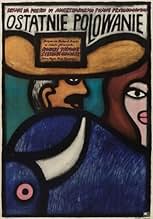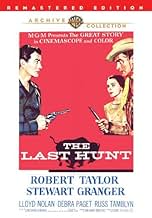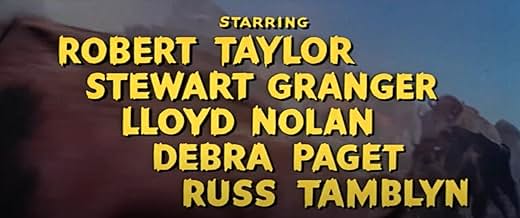IMDb-BEWERTUNG
6,8/10
1971
IHRE BEWERTUNG
Füge eine Handlung in deiner Sprache hinzuIn 1883 South Dakota, two buffalo hunters start a personal feud over a captured squaw and a stand-off with a Dakota raiding party over some stolen horses.In 1883 South Dakota, two buffalo hunters start a personal feud over a captured squaw and a stand-off with a Dakota raiding party over some stolen horses.In 1883 South Dakota, two buffalo hunters start a personal feud over a captured squaw and a stand-off with a Dakota raiding party over some stolen horses.
- Regie
- Drehbuch
- Hauptbesetzung
Joe De Santis
- Ed Black
- (as Joe DeSantis)
Roy Barcroft
- Maj. Smith
- (Nicht genannt)
Jimmie Booth
- Barfly
- (Nicht genannt)
Steve Darrell
- Wells Fargo Man
- (Nicht genannt)
Rosemary Johnston
- Woman
- (Nicht genannt)
Casey MacGregor
- Bit Role
- (Nicht genannt)
Jerry Martin
- Barber
- (Nicht genannt)
Empfohlene Bewertungen
The film largely focuses on a bullying Robert Taylor as a ruthless buffalo hunter and the people who have to put up with him. Set amidst a hunt for dwindling numbers of buffalo, it portrays the end of a tragic era of senseless slaughter and is full of drama and remorse for both the buffalo and the Native Americans. Taylor is blinded by his hatred of Indians and his naivete that the buffalo herds will never disappear. In one scene, he shoots animal after animal, while in another he murders Indians and then eats the food they had cooking on their fire. Under this ruthless exterior lies an insecure person who is reduced to begging his comrades (Stewart Granger, Lloyd Nolan, and Russ Tamblyn) not to leave him. It's not the most pleasant of films and is weighed down by the drama it creates, leading to a dismal and very fitting conclusion in a blizzard.
The Last Hunt is directed by Richard Brooks who also adapts the screenplay from the novel of the same name written by Milton Lott. It stars Robert Taylor, Stewart Granger, Debra Paget, Lloyd Nolan and Russ Tamblyn. Out of MGM it's a CinemaScope/Eastman Color production with music by Daniele Amfitheatrof and cinematography by Russell Harlan.
Buffalo hunter Sandy McKenzie (Granger) is tired of the hunt, but after a quirk of fate leaves him financially struggling, he accepts an invitation from Charles Gilson (Taylor) to go out on another profitable hunt. But when out on the range, Charlie starts to show a sadistic streak, and after his capture of an Indian girl (Paget), the two men are driven even further apart. Something will have to give.
It's quite often forgotten that one of the key weapons of war is food. The buffalo was an integral animal to the Native American way of life for a number of reasons, be it food, shelter, clothes or religious worth, it was an animal of great substance. So killing them off was a viable tactic for the white man during the Indian wars. The start of Richard Brooks' film tells us that in 1853 there were 60 million buffalo in the West, but within 30 years their number would be only 30 thousand...
What unfolds in this bleak but most potent of pictures, is a tale of men emotionally battered, albeit differently, by the war, a tale tinted (tainted) by racism and ecological concerns. Essentially it's Granger's tired of it all Sandy McKenzie against Taylor's blood lust racist Charles Gilson. In the middle is Paget's Indian girl, who is courted by McKenzie but owned unwillingly by Gilson, while on the outskirts observing are the skinners, half-breed Jimmy (Tamblyn) and Woodfoot (Nolan). McKenzie can barely pull the trigger to shoot the buffalo, his inner torment etched all over his face, but Gilson can fire rapidly, a maniacal glee surfaces with each buffalo death he administers. To Gilson, one less buffalo is one less Indian, his hatred of the Indian born out when he gets chance to kill those Indians that come to be in his way.
Is it the same kind of feeling you get around a woman?
The screenplay positively pings with intelligence and thought for its subjects, crucial given that it is essentially an intimate five character piece. Brooks is aware that the themes dwelling in his movie need to be handled with care, to take a sledgehammer to make a point would be wrong. With the exception of Paget (not her fault as she plays it as written) he garners great performances from his cast, with Taylor and Granger excellent and proving to be good foil for each other. Taylor has Gilson as outright scary and nasty, but there is a shade of sympathy asked of us viewers for he is a troubled mind. When a rumble of thunder pierces the sky above the group's camp, Gilson thinks it's a buffalo herd in flight, off he goes frantically in search of more kills, practically frothing at the mouth. This man clearly needs help, but out there on the frontier there is no help for battle scarred minds.
With actual footage of buffalo killings cut into the film (part of the government thinning of the herd programme), there's plenty to feel sombre about. However, there is great beauty to be found by way of Russell Harlan's photography out of Badlands National Park and Custer State Park. These lands were once home to much pain and misery, but forever beautiful they be and in Harlan's hands they offer up another reason why The Last Hunt is essential viewing for the Western fan. It's brilliant, one of the unsung classics of 50s Westerns and proof positive that Robert Taylor, when challenged to do so, could indeed act very well. 9/10
Buffalo hunter Sandy McKenzie (Granger) is tired of the hunt, but after a quirk of fate leaves him financially struggling, he accepts an invitation from Charles Gilson (Taylor) to go out on another profitable hunt. But when out on the range, Charlie starts to show a sadistic streak, and after his capture of an Indian girl (Paget), the two men are driven even further apart. Something will have to give.
It's quite often forgotten that one of the key weapons of war is food. The buffalo was an integral animal to the Native American way of life for a number of reasons, be it food, shelter, clothes or religious worth, it was an animal of great substance. So killing them off was a viable tactic for the white man during the Indian wars. The start of Richard Brooks' film tells us that in 1853 there were 60 million buffalo in the West, but within 30 years their number would be only 30 thousand...
What unfolds in this bleak but most potent of pictures, is a tale of men emotionally battered, albeit differently, by the war, a tale tinted (tainted) by racism and ecological concerns. Essentially it's Granger's tired of it all Sandy McKenzie against Taylor's blood lust racist Charles Gilson. In the middle is Paget's Indian girl, who is courted by McKenzie but owned unwillingly by Gilson, while on the outskirts observing are the skinners, half-breed Jimmy (Tamblyn) and Woodfoot (Nolan). McKenzie can barely pull the trigger to shoot the buffalo, his inner torment etched all over his face, but Gilson can fire rapidly, a maniacal glee surfaces with each buffalo death he administers. To Gilson, one less buffalo is one less Indian, his hatred of the Indian born out when he gets chance to kill those Indians that come to be in his way.
Is it the same kind of feeling you get around a woman?
The screenplay positively pings with intelligence and thought for its subjects, crucial given that it is essentially an intimate five character piece. Brooks is aware that the themes dwelling in his movie need to be handled with care, to take a sledgehammer to make a point would be wrong. With the exception of Paget (not her fault as she plays it as written) he garners great performances from his cast, with Taylor and Granger excellent and proving to be good foil for each other. Taylor has Gilson as outright scary and nasty, but there is a shade of sympathy asked of us viewers for he is a troubled mind. When a rumble of thunder pierces the sky above the group's camp, Gilson thinks it's a buffalo herd in flight, off he goes frantically in search of more kills, practically frothing at the mouth. This man clearly needs help, but out there on the frontier there is no help for battle scarred minds.
With actual footage of buffalo killings cut into the film (part of the government thinning of the herd programme), there's plenty to feel sombre about. However, there is great beauty to be found by way of Russell Harlan's photography out of Badlands National Park and Custer State Park. These lands were once home to much pain and misery, but forever beautiful they be and in Harlan's hands they offer up another reason why The Last Hunt is essential viewing for the Western fan. It's brilliant, one of the unsung classics of 50s Westerns and proof positive that Robert Taylor, when challenged to do so, could indeed act very well. 9/10
I had watched several days film shooting of this movie that summer,the end result was just two scenes in the movie. The location was Sylvan Lake in the Black Hills. Bring the wagon,stop the wagon etc . So this Dakota youth looked forward to seeing the movie and was not disappointed. The local buffalo herd was being culled so the shooting scenes were for real. (yes Doris, animals were hurt during filming) I think the ending was copied by Jack Nicholson in the Shining? A great western/social comment from the 50's. This should be in the same class as High Noon for real western drama or used as a social statement like Blackboard Jungle or Rebel Without A Cause was for 50's youth.
The Last Hunt is one of the few westerns ever made to deal with Buffalo hunting, both as a sport and business and as a method of winning the plains Indian wars. Before the white man set foot on the other side of the Mississippi, the plains used to have herds of American Bison as large as some of our largest cities. By the time of the period The Last Hunt is set in, the buffalo had been all but wiped out. The 20th century, due to the efforts of conservationists, saw a revival in population of the species, but not hardly like it once was.
Robert Taylor and Stewart Granger are co-starring in a second film together and this one is far superior to All the Brothers Were Valiant. Here Stewart Granger is the good guy, a world weary buffalo hunter, who has to go back to a job he hates because of financial considerations.
The partner he's chosen to throw in with is Robert Taylor. Forgetting Taylor for the moment, I doubt if there's ever been a meaner, nastier soul than Charlie Gilsen who Taylor portrays. In Devil's Doorway he was an American Indian fighting against the prejudice stirred up by a racist played by Louis Calhern. In The Last Hunt, he's the racist here. He kills both buffalo and Indians for pure pleasure. He kills one Indian family when they steal his mules and takes the widow of one captive. Like some barbarian conqueror he expects the pleasure of Debra Paget's sexual favors. He's actually mad when Paget doesn't see it that way.
No matter how often they refer to Russ Tamblyn as a halfbreed, I was never really convinced he was any part Indian. It's the only weakness I found in The Last Hunt.
However Lloyd Nolan, the grizzled old buffalo skinner Taylor and Granger bring along is just great. Nolan steals every scene he's in with the cast.
For those who like their westerns real, who want to see a side of Robert Taylor never seen on screen, and who don't like cheap heroics, The Last Hunt is the ideal hunt.
Robert Taylor and Stewart Granger are co-starring in a second film together and this one is far superior to All the Brothers Were Valiant. Here Stewart Granger is the good guy, a world weary buffalo hunter, who has to go back to a job he hates because of financial considerations.
The partner he's chosen to throw in with is Robert Taylor. Forgetting Taylor for the moment, I doubt if there's ever been a meaner, nastier soul than Charlie Gilsen who Taylor portrays. In Devil's Doorway he was an American Indian fighting against the prejudice stirred up by a racist played by Louis Calhern. In The Last Hunt, he's the racist here. He kills both buffalo and Indians for pure pleasure. He kills one Indian family when they steal his mules and takes the widow of one captive. Like some barbarian conqueror he expects the pleasure of Debra Paget's sexual favors. He's actually mad when Paget doesn't see it that way.
No matter how often they refer to Russ Tamblyn as a halfbreed, I was never really convinced he was any part Indian. It's the only weakness I found in The Last Hunt.
However Lloyd Nolan, the grizzled old buffalo skinner Taylor and Granger bring along is just great. Nolan steals every scene he's in with the cast.
For those who like their westerns real, who want to see a side of Robert Taylor never seen on screen, and who don't like cheap heroics, The Last Hunt is the ideal hunt.
In 1883, in South Dakota, the former buffalo hunter Sandy McKenzie (Stewart Granger) is tired of hunting the animals. He is approached by Charlie Gilson (Robert Taylor), a man that feels pleasure in killing buffalo and Indians, who proposes a high salary to him to hunt buffalo for him. They associate to each other and hire the skilled skinner Woodfoot (Lloyd Nolan) and the half-breed Jimmy O'Brien (Russ Tamblyn) to help them.
When a group of Indians steal their horses, Charlie hunts them down and kills them in their camp. Charlie finds a gorgeous Indian girl (Debra Paget) with a baby boy and he brings her to his camp to be his woman. However, Sandy and she are attracted to each other but they fear Charlie. Along the days, the tension between them increases until the day Charlie kills a white buffalo that is sacred for the Indians.
"The Last Hunt" is a gritty and brutal western in a period when the Old West is ending. Robert Taylor and Stewart Granger have great performances and Debra Paget is in top of her beauty and responsible for an increasing tension between the two lead characters.
The cruel scenes where the buffalo are killed by marksmen are for real and part of the reduction of the herd planned by the government of USA. My vote is seven.
Title (Brazil): "A Última Caçada" ("The Last Hunt")
When a group of Indians steal their horses, Charlie hunts them down and kills them in their camp. Charlie finds a gorgeous Indian girl (Debra Paget) with a baby boy and he brings her to his camp to be his woman. However, Sandy and she are attracted to each other but they fear Charlie. Along the days, the tension between them increases until the day Charlie kills a white buffalo that is sacred for the Indians.
"The Last Hunt" is a gritty and brutal western in a period when the Old West is ending. Robert Taylor and Stewart Granger have great performances and Debra Paget is in top of her beauty and responsible for an increasing tension between the two lead characters.
The cruel scenes where the buffalo are killed by marksmen are for real and part of the reduction of the herd planned by the government of USA. My vote is seven.
Title (Brazil): "A Última Caçada" ("The Last Hunt")
Wusstest du schon
- WissenswertesUS government marksmen shot and killed buffalo during production as part of a scheduled herd-thinning. Close observation of the film reveals that the buffalo were shot in the head, which is why they would fall straight to the ground where they were standing.
- PatzerAlle Einträge enthalten Spoiler
- Zitate
Indian Girl: You take away our food and now you kill our religion.
- VerbindungenFeatured in MGM Parade: Folge #1.20 (1956)
Top-Auswahl
Melde dich zum Bewerten an und greife auf die Watchlist für personalisierte Empfehlungen zu.
- How long is The Last Hunt?Powered by Alexa
Details
Box Office
- Budget
- 2.121.000 $ (geschätzt)
- Weltweiter Bruttoertrag
- 4.236 $
- Laufzeit
- 1 Std. 39 Min.(99 min)
- Seitenverhältnis
- 2.35 : 1
Zu dieser Seite beitragen
Bearbeitung vorschlagen oder fehlenden Inhalt hinzufügen


